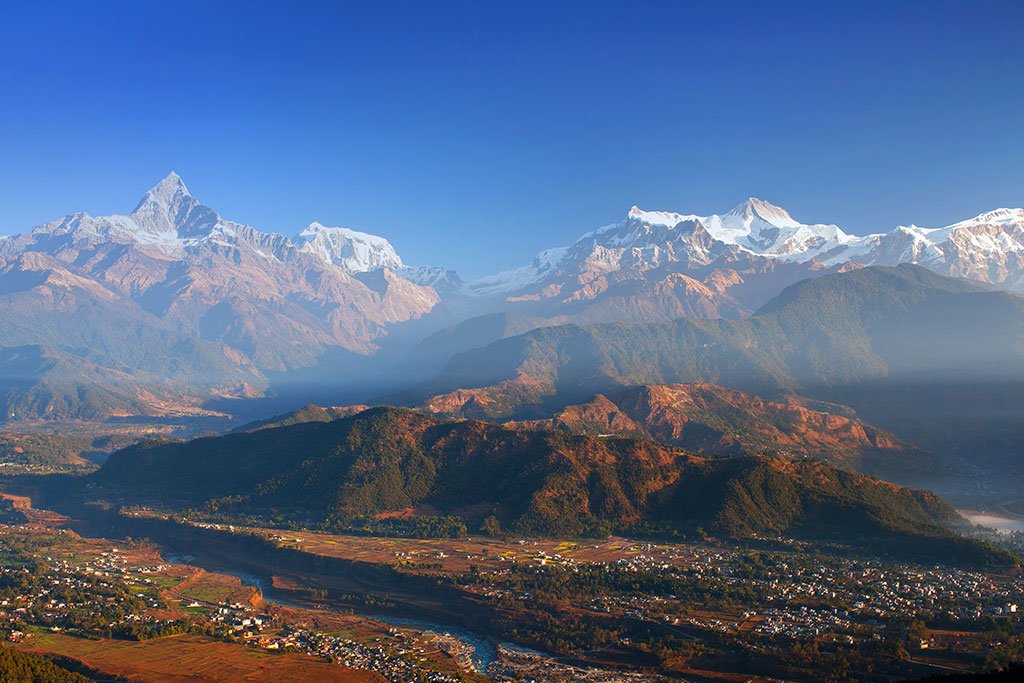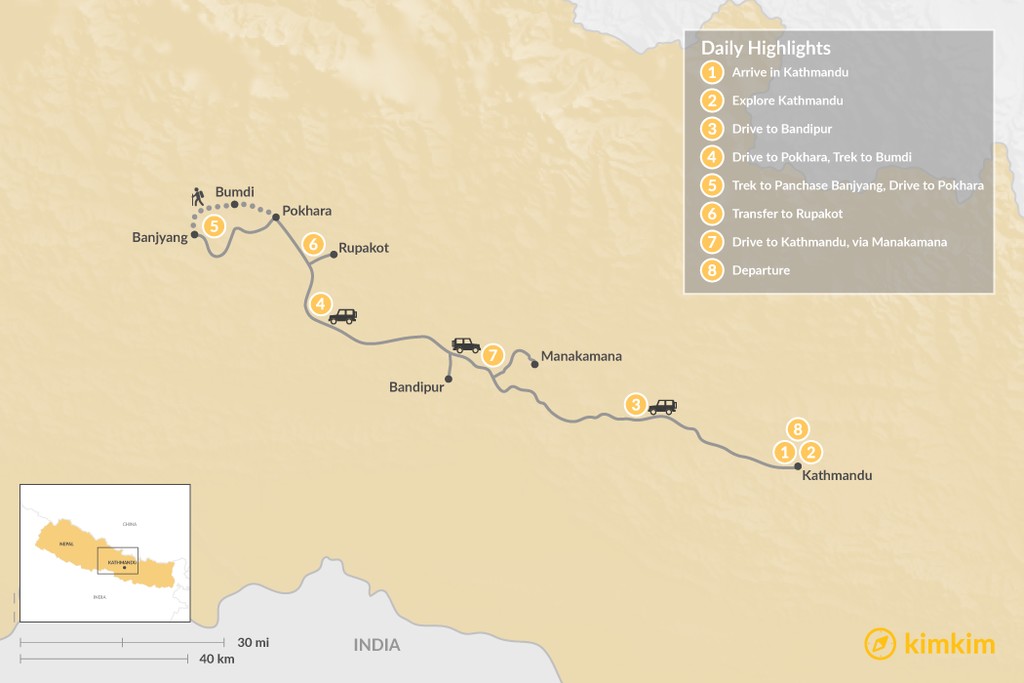
Kathmandu & Pokhara Valleys - 8 Days

Highlights
- Enjoy the peace of Bandipur, a hilltop town with incredible views
- Spot “fishtail peak” (Machapuchare) from Pokhara’s World Peace Pagoda
- Marvel at three of the tallest mountains in the world — Annapurna I, Dhaulagiri and Manaslu — while trekking through forest
- Visit Rupa Lake, a lesser-visited lake near Pokhara
- Climb the stairs to Swayambhunath, Kathmandu’s famous ‘Monkey Temple’, before sipping chai at Kathmandu Durbar Square
Chat with a local specialist who can help organize your trip.
Brief Itinerary
| Day | Highlights | Overnight |
|---|---|---|
| Day 1 | Welcome to Kathmandu! | Kathmandu |
| Day 2 | Explore Kathmandu | Kathmandu |
| Day 3 | Kathmandu to Bandipur | Bandipur |
| Day 4 | Bandipur to Pokhara, trek to Bumdi (1,520 m) | Bumdi |
| Day 5 | Bumdi to Panchase Banjyang (2,065 m), drive to Pokhara | Pokhara |
| Day 6 | Pokhara to Rupakot | Rupakot |
| Day 7 | Rupakot to Kathmandu, via Manakamana | Kathmandu |
| Day 8 | Depart Kathmandu |
Detailed Itinerary
Day 1: Welcome to Kathmandu!

Depending on when you arrive in Kathmandu, there may be time to start with some great sightseeing. Head to the Kathmandu Durbar Square, a twenty-minute walk south of Thamel, the tourist hub where most people stay. This public space houses an eclectic mix of architectural styles, from sixteenth-century pagoda temples to early twentieth-century neo-classical Gadi Durbar Palace. Linger into the early evening, as many of Kathmandu’s religious public spaces come alive at dusk when people come to worship at the temples and shrines.
Day 2: Explore Kathmandu

Kathmandu has a special atmosphere during the early morning hours when the city is slowly coming to life yet not too chaotic. It's a great time to walk and explore the streets or have a chai overlooking one of the local courtyards or durbar squares. There are a number of ways you can spend the day given the many incredible sights around the Kathmandu Valley. Later in the evening, head out for dinner at one of the city's great eateries, or your specialist can arrange a home-cooked dinner with a local family.
Day 3: Kathmandu to Bandipur

From Kathmandu head west to Bandipur, about four hours’ drive away. Bandipur is a small town perched high on a ridge, at 1030 meters. As the center of the old town is pedestrianized, you can walk among the red-brick temples and traditional old homes without the same stress of traffic as in Kathmandu. Bandipur used to be an important center of garment manufacturing and was a trading stop along the India-Tibet route.
There are a couple of fine boutique guesthouses in Bandipur, renovated houses belonging to the town’s ethnic Newar people, including Gaun Ghar and The Old Inn.
Day 4: Bandipur to Pokhara, trek to Bumdi

The lakeside town of Pokhara is about two hours west of Bandipur. A popular activity is to go boating on Phewa Lake, so we’ll first take a trip to the other side of the lake before beginning today’s trek. From the World Peace Pagoda, if the weather is clear, you will have great mountain views of the Annapurna Himalaya. The most distinctive peak is Machapuchare, the fish-tail peak visible from Pokhara.
After a decent, the rest of the trek to the village of Bumdi will be gently up and down. The overnight stay in Bumdi will allow you to learn about the Magar and Brahman people of this village, and understand village and mountain life in Nepal.
Day 5: Bumdi to Panchase Banjyang (2065 meters), drive to Pokhara

Today’s hike will take you through forests with a rich variety of trees and birdlife. In the spring, you will likely see the pink, red and purple blooms of rhododendron flowers, Nepal’s national flower. The Annapurna range will be visible through clearings in the forest, including three of the highest mountains in the world: Annapurna I, Dhaulagiri and Manaslu.
After arriving in the village of Panchase Banjyang, a car will take you back to Pokhara. The town is an ideal place to shop for Nepal-made souvenirs, such as handmade paper, woollen clothing and Tibetan-style jewelry. Pokhara also has some of the best international cuisines in the country (plus great happy hour drink specials to enjoy while watching the sunset over Phewa Lake).
Day 6: Pokhara to Rupakot
While Pokhara is busy and popular, Phewa Lake is not the only lake in the area. Today you will go to Rupakot, overlooking Rupa Lake, just 15 km from Pokhara. Rupa Lake is hidden within a steep-sided valley. It is much quieter and less developed than Pokhara, as hardly any visitors come here, so is an idyllic spot in which to relax after the trek.
There are teahouse-style lodgings around Rupa Lake, but for a more luxurious experience with mountain and lake views from on high, enjoy a stay at Rupakot Resort.
Day 7: Rupakot to Kathmandu, via Manakamana

Today’s drive back to Kathmandu is bumping and winding, but incredibly scenic. The Prithvi Highway is the main road linking Pokhara and Kathmandu. It follows the Trisuli River for much of the way, passing steep rice terraces and small riverside villages.
Stop at the rough half-way point to visit the famous temple at Manakamana. At the highway town of Kurintar, on the Trisuli River, is a long and scenic cable-car that will take you up to Manakamana. You can look down on the rice fields and the river below (look out for white-water rafters drifting past!).
Although the Manakamana temple itself is being rebuilt after destruction in the 2015 earthquake, it still attracts many pilgrims from around India and Nepal. On a good day, you can see the Annapurna Himalaya from the town, which sits about 700 meters higher than the highway road.
Day 8: Depart Kathmandu

Depending on your time of departure, there may be time to check out some more of Kathmandu’s rich cultural heritage. Get up early to climb the 300 steps up to Swayambhunath, also known as Monkey Temple, in the cooler early morning air. This Buddhist stupa is located on a hill two km west of Thamel and offers great views of the city. It is a particularly holy place for Nepal’s Tantric Buddhists. If you have time in the late morning or afternoon, head back to Thamel for some souvenir shopping. Don’t forget to bargain hard!
